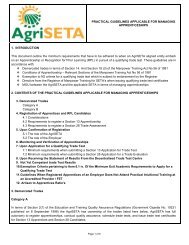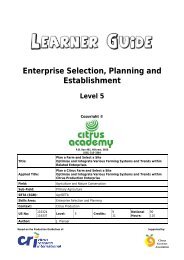Evaluate Basic External Animal Anatomy and Morphology - AgriSETA
Evaluate Basic External Animal Anatomy and Morphology - AgriSETA
Evaluate Basic External Animal Anatomy and Morphology - AgriSETA
- No tags were found...
Create successful ePaper yourself
Turn your PDF publications into a flip-book with our unique Google optimized e-Paper software.
<strong>Evaluate</strong> <strong>Basic</strong> <strong>External</strong> <strong>Animal</strong> <strong>Anatomy</strong> <strong>and</strong> <strong>Morphology</strong>Primary Agriculture NQF Level 1 Unit St<strong>and</strong>ard No: 11617391.1 Fish3. ReptilesFor example: Snake, lizard, chameleon, tortoise, <strong>and</strong> crocodile.4. BirdsFor example: Cape Sparrow, chicken, ostrich, dove.5. MammalsFor example: Rabbit, dog, cat, sheep, cattle, whale, human.Fish display a great variety of forms <strong>and</strong> are adapted to the environment in whichthey live in many ways. There are two groups of fish in the class that differs in thecomposition of their bones. These are the bony fish (fish with well developed hardbones) like the silver fish <strong>and</strong> galjoen <strong>and</strong> the cartilaginous (fish with soft flexiblefibrous bones called cartilage) fish like the shark.Fish serve as a major source of food to other living beings. Humans consume a lot offish. Fish by-products are used in animal rations as a good protein source.<strong>External</strong> parts of a bony fish Body shapesThe shape of the body of a fish is well adapted for little resistance in water.This enables the fish to move quickly through water.The body of a fish is spindle (oval body that tapers down on both sides)shaped with the broader portion in front; <strong>and</strong> it is flattened on the sides.Although there are variations on the mentioned shape, the variations servethe individual most of the time to adapt to its immediate surroundings. Body coverThe body cover of fish assists the animal to travel rapidly through thewater. The skin develops scales. Scales reduce the resistance of the fish’smovement through water.Large numbers of mucous gl<strong>and</strong>s occur in the skin of fish. These gl<strong>and</strong>ssecrete mucus, which makes the body smooth <strong>and</strong> allows easy movementthrough the water medium. Even the gill slits (openings of the gills)assist with the movement of the fish through water.Version: 01 Version Date: July 2006
















